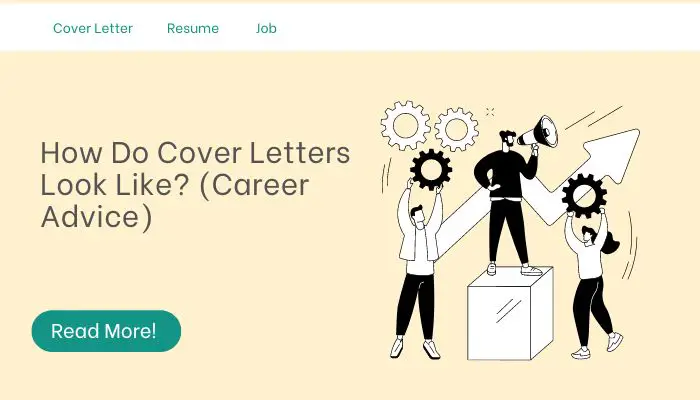A cover letter is a written document that accompanies your resume. It’s important to know how to write a good cover letter, as it helps you stand out from other candidates and shows that you have the skills and experience for the job.
| Takeaways |
|---|
| Cover letters are an important part of your job application. |
| A well-written cover letter can help you stand out from other applicants. |
| Your cover letter should be tailored to each job you apply to. |
| Your cover letter should be concise and to the point. |
| Be sure to proofread your cover letter carefully before submitting it. |
How Do Cover Letters Look Like?
In most cases, a cover letter should be no longer than one page. This is not only because it is easier to read and therefore more likely to get you noticed, but also because it shows that you can focus on your writing skills.
In general, cover letters should follow the same format as the resume and can be used for all kinds of job applications. They should include:
- The person’s name whom you are addressing (e.g., Hiring Manager)
- Your full name and contact information
- The date on which you sent in your application/CV/resume (if applicable)
When it comes to cover letters, the appearance matters. Your cover letter should look professional and organized. Check out our guide on what a cover letter looks like to make sure you’re on the right track.
How Do I Write A Cover Letter For A Job?
A cover letter is a way to introduce yourself to the employer. It should be tailored to the specific job description, ideally including some information that was not provided in your resume. You can even tailor your cover letter depending on what kind of job you are applying for.
For example, if you’re applying for an entry-level position at a company, you might mention how excited you are about the opportunity and how much potential it has for growth; whereas if you’re applying for a senior position, it would make sense to focus on your experience and why that makes you qualified.
The best way to write a good cover letter is by being personal while also maintaining professionalism. It should feel like someone wrote this specifically with YOU in mind—not just anyone who happens to have similar qualifications as them!
How Do You Write A Letter Of Interest And Application?
You can use a letter of interest to:
- Introduce yourself and your skills, qualifications, or experience to a potential employer.
- Explain why you’re interested in working for the company, and why they should hire you.
- Highlight any relevant skills or experience that makes you a good fit for the position.
An application is typically sent after an interview when you’re asked to submit a formal application before moving forward with hiring discussions. It’s used as a way for employers to gather basic personal information about applicants during this stage of the hiring process.
How Can I Write A Good Application Letter?
- Start with a greeting.
- Introduce yourself and your qualifications for the job you are applying for.
- State the position you are applying for.
Provide a summary of your qualifications. This can include things like coursework, projects, extracurricular activities, and any other experiences that may be relevant to this position or industry field. If possible, use numbers (ex: “I have completed over 50 hours of research”) to demonstrate these skills and knowledge in an easily understandable way.
End with a closing sentence thanking them for their time reading through your application letter and hope to hear from them soon! Make sure to sign your name as well!
The opening lines of your cover letter are crucial as they set the tone for the rest of your application. Want to make sure you’re starting strong? Read our guide on how to start writing a cover letter for some great tips and examples.
What Is The Format Of A Resignation Letter?
A resignation letter has the following format:
Salutation (Dear Mr. John Smith or Dear Sir)
Body (I am writing this letter to inform you that I am resigning from my current job on a date.)
Closing (Yours truly, Jane Doe)
Signature block with Name & Designation, Phone Number, and Email ID/Contact details of the employee
Enclosure-Attach a copy of your resume.
What Should Be Included In A Formal Letter?
A cover letter should include all of the following:
- Company name
- Date
- Address
- Name of person you are writing to. Make sure this is spelled correctly!
Salutation, which is usually “Dear Ms./Mr. Lastname” and can be followed by a comma or other punctuation depending on what follows. If the first sentence in your letter starts with an address, then you won’t need a salutation at all just start writing at that point. For example Dear Mrs., I am writing to apply for the position of…
Body of the letter (where you write about yourself and why you’re qualified for this job) that contains no fewer than 3 paragraphs but no more than 5 paragraphs overall, each ending with its period (or some other appropriate punctuation).
Try not to go over five paragraphs unless necessary because if there’s ever any confusion about what was said in those final two sentences, it may be difficult for someone else who reads them later down the line (like an interviewer!)-Company Letterhead Template Get Started Now!
What Is The First Paragraph Of A Business Letter Called?
A business letter is made up of five sections:
The salutation should be addressed to the person you’re writing to. The salutation is often followed by a comma and then the person’s title (Mr., Ms., Dr., etc.). If you don’t know their title, just use their first name.
In the introduction, where you give your reason for writing and make any relevant introductions. Introducing yourself is optional in most cases if it’s not necessary because they already know who you are
If there’s not much room left on the page after including everything else in your letter then don’t waste time introducing yourself! Get straight into what needs to be said next instead.
The body paragraphs (or paragraphs), where each paragraph has an idea or topic sentence that expands upon what was said previously in that paragraph before moving on its own accord towards making new points about whatever subject matter we’re talking about here today
These segments should all come together at some point towards making one cohesive argument overall so it doesn’t seem like they’re just random ideas thrown around without any thought behind them being given.”
Are you feeling overwhelmed and unsure where to start with your cover letter? Our guide on all you need to know about cover letters covers everything from formatting to content, so you can feel confident in your application.
What Are The Four Major Parts Of An Effective Cover Letter?
There are four major parts of an effective cover letter:
- Introduction
- Body
- Conclusion
- Signature
To stand out in a crowded job market, it’s important to understand how cover letters work. Check out our guide on how do cover letters work for insights on what recruiters are looking for and how to make your cover letter stand out.
How Do I Create An Attractive Resume And Cover Letter?
To create an attractive resume and cover letter, start by finding a template that you like. For example, you can use the free resume templates offered by Microsoft Word or download one from Google Docs, which allows you to edit the template and make it your own.
Next, choose a professional font for your resume. Serif fonts (fonts with little feet on them) are usually considered more formal than sans serif fonts (fonts without feet).
If you’re not sure what kind of font looks best on paper but still want something easy to read, Times New Roman is recommended as it’s a common choice among most people who have to write professionally. Don’t forget about grammar; proofreading is important because even small errors can reflect poorly on how serious someone is about their work!
Finally, don’t overdo it when using graphics in your cover letter or resume summary section it’s better if these documents focus more on content rather than style!
Some job seekers underestimate the importance of a cover letter, but it can be a powerful tool in your job search. Want to learn more about why cover letters are so important? Check out our guide on how important is a cover letter when applying for a job to discover how it can make a difference in your application.
Conclusion
If you want to make your cover letter stand out from the crowd, consider adding a professional flair to it.
A good way to do this is by including a personal touch and mentioning how your skills are a perfect fit for the role. You can also show off your personality and knowledge of the company by incorporating keywords into your letter as well!
Further Reading
Here are some additional resources to help you write a great cover letter:
MyPerfectResume: This article provides a step-by-step guide to writing a cover letter, with tips on formatting and content.
Indeed: This comprehensive guide covers everything from the basics of cover letters to specific examples and templates.
Novoresume: This guide provides tips and examples for crafting a cover letter that will make you stand out to recruiters.
FAQs
What should I include in my cover letter?
Your cover letter should include a brief introduction, a statement about why you’re interested in the job, specific examples of your relevant experience or skills, and a conclusion that thanks the recruiter for their time.
Should I customize my cover letter for each job I apply to?
Yes, it’s a good idea to customize your cover letter for each job you apply to. This shows that you’ve done your research and are genuinely interested in the position.
How long should my cover letter be?
Your cover letter should be one page or less. Keep it concise and to the point.
What’s the best way to address my cover letter?
Try to address your cover letter to a specific person if possible. If you can’t find the name of the hiring manager, “Dear Hiring Manager” or “To Whom It May Concern” are both acceptable options.
What are some common mistakes to avoid in a cover letter?
Some common mistakes to avoid include using a generic template, including irrelevant information, and making spelling or grammar mistakes. Be sure to proofread your cover letter carefully before submitting it.

Costantine Edward is a digital marketing expert, freelance writer, and entrepreneur who helps people attain financial freedom. I’ve been working in marketing since I was 18 years old and have managed to build a successful career doing what I love.
